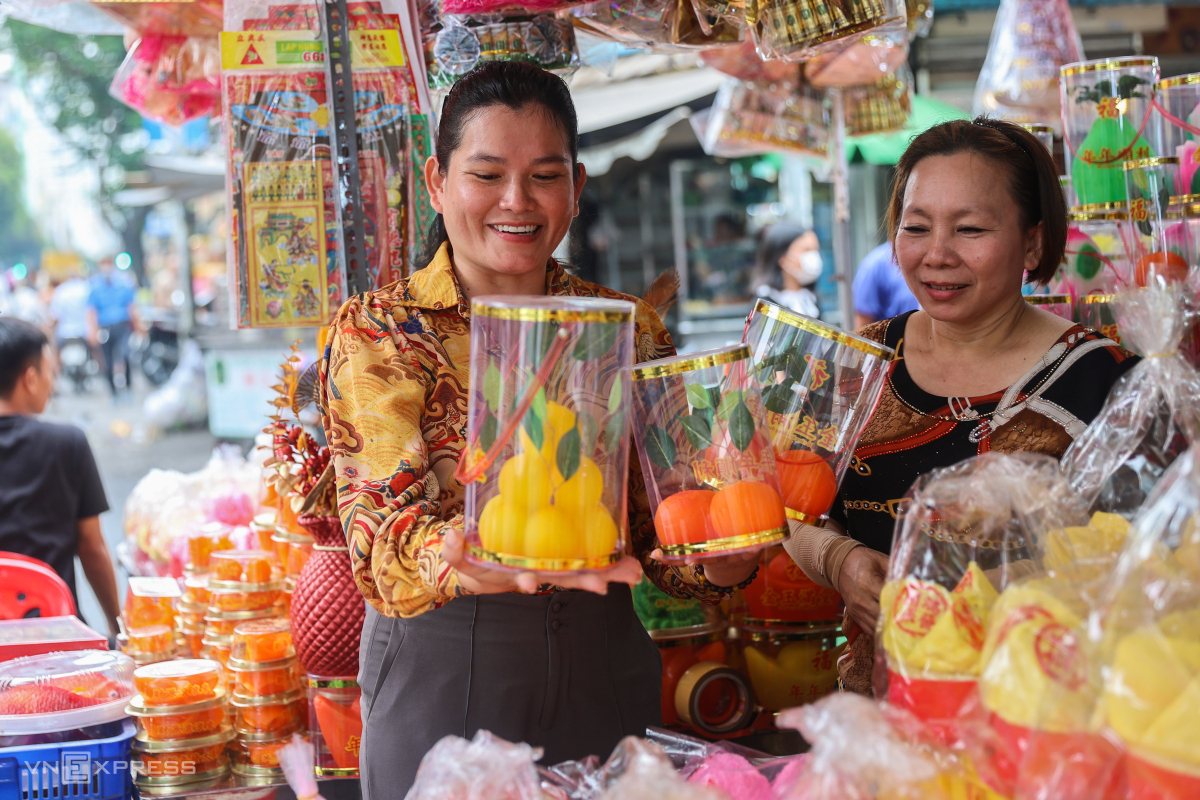On the corner of Phung Hung and Nguyen Trai streets, the Hoa community’s cake market blooms like a garden every Tet holiday season, standing on a rich history of over 50 years. As the Lunar New Year approaches, colorful cake stalls crop up to adorn street corners and begin attracting customers around the 10 days ahead of the Lunar New Year, which begins this Saturday.
The city’s community of Sino-heritage, known as the Hoa people, put on the cake market every year featuring a variety of traditional cakes that symbolize good fortune and auspiciousness, including banh to and banh phat tai.
For the beginning of the new year, the Hoa community traditionally offers cakes such as banh to (sweet rice cake), banh thuan (steamed sponge cake), banh phat tai (Chinese prosperity cake), banh trai luu (pomegranate-shaped cake), and banh xep (crispy dumplings). Additionally, the market provides items for decorating family altars and homes during Tet.
Chung My Phuong, a 45-year-old vendor on Phung Hung Street, has been selling these cakes for over 30 years. She noted that banh trai luu, banh xep, and banh to are the top sellers during Tet. “The Hoa people always have these types of cakes in their Lunar New Year's offerings," she shared.
Phuong's cakes are primarily made by her family members. She noted that almost every stall boasts a long-standing history and enjoys a bustling trade during Tet.

On Feb. 5, five days before the Lunar New Year, My Quyen, 65, from Binh Tan District visited the market to buy cakes and altar decorations. These cakes, sold by weight, are typically priced around VND300,000 ($12) per kilogram.
"I purchased 6 pomegranate-shaped cakes for VND500,000. For the Hoa people, these cakes are essential during the Lunar New Year," Quyen said.
At the neighboring stall, Nguyen Thi Thu Vui from District 5 purchased 8 peach-shaped cakes for Tet offerings, for a total cost of VND1 million. "My husband is part of the Hoa community, so I've been coming to this market every Tet to buy decorations," she explained.

Banh to has a flat, round shape made from glutinous rice flour and sugar, then steamed. Typically, it is white and yellow with red letters printed on top. These cakes are priced at about VND25,000 - VND100,000 ($1 to $4) each, depending on their size.
To the Hoa people, banh to is also referred to as sticky cake, symbolizing family unity when shared. Moreover, when referred to in Sino-Vietnamese as nien cao, the cake embodies a hope for a more prosperous new year. Therefore, this dish holds significant importance in Lunar New Year offerings for the Hoa community.
Banh phat tai features a spongy texture akin to sponge cake, made from fermented rice flour. When the cake is baked, it puffs up and splits into four parts, looking like a flower.
The Chinese word for cake is a homonym, as it refers to both the cake's expanding during baking and symbolizes rising in life. The cake symbolizes prayers for prosperity and luck in one's work.

As Tet approaches, the market buzzes with activity, reaching its peak on the day before the Lunar New Year.
While still operational on regular weekdays, the market's liveliness is unmatched during Tet.
Nearby attractions include On Lang Assembly Hall, Nghia An Assembly Hall, Ba Thien Hau Pagoda, Luong Nhu Hoc lantern street, Hai Thuong Lan Ong herbal medicine street, and various eateries highlighting Saigon's Hoa cultural heritage.














